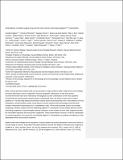| dc.contributor.author | Rickelt, Steffen | |
| dc.contributor.author | Hynes, Richard O | |
| dc.date.accessioned | 2018-10-30T15:20:06Z | |
| dc.date.available | 2018-10-30T15:20:06Z | |
| dc.date.issued | 2017-12 | |
| dc.identifier.issn | 0036-8075 | |
| dc.identifier.issn | 1095-9203 | |
| dc.identifier.uri | http://hdl.handle.net/1721.1/118804 | |
| dc.description.abstract | Bone has a well-established role in advanced cancer. It provides a supportive microenvironment for the growth of metastatic cells that escape the primary tumor, which ultimately leads to loss of bone mass. Engblom et al. show that bone may also contribute to early-stage tumorigenesis through a mechanism that leads to an increase in bone mass (see the Perspective by Zhang and Lyden). In mouse models of lung adenocarcinoma, primary tumor cells remotely activated bone-resident cells called osteoblasts, which have a bone-building function. The activated osteoblasts in turn triggered production of a certain type of neutrophil that infiltrates the primary tumor and promotes its growth. Patients with early-stage lung cancer were also found to have an increase in bone density, consistent with the findings in mice. | en_US |
| dc.description.sponsorship | National Institutes of Health (U.S.) (Grant U54-CA163109) | en_US |
| dc.description.sponsorship | Howard Hughes Medical Institute | en_US |
| dc.description.sponsorship | Massachusetts Institute of Technology. Ludwig Center for Molecular Oncology (Postdoctoral Fellowship) | en_US |
| dc.language.iso | en_US | |
| dc.publisher | American Association for the Advancement of Science (AAAS) | en_US |
| dc.relation.isversionof | http://dx.doi.org/10.1126/science.aal5081 | en_US |
| dc.rights | Creative Commons Attribution-Noncommercial-Share Alike | en_US |
| dc.rights.uri | http://creativecommons.org/licenses/by-nc-sa/4.0/ | en_US |
| dc.source | Prof. Hynes via Courtney Crummett | en_US |
| dc.title | Osteoblasts remotely supply lung tumors with cancer-promoting SiglecF | en_US |
| dc.type | Article | en_US |
| dc.identifier.citation | Engblom, Camilla, et al. “Osteoblasts Remotely Supply Lung Tumors with Cancer-Promoting SiglecF High Neutrophils.” Science, vol. 358, no. 6367, Dec. 2017, p. eaal5081. | en_US |
| dc.contributor.department | Massachusetts Institute of Technology. Department of Biology | en_US |
| dc.contributor.department | Koch Institute for Integrative Cancer Research at MIT | en_US |
| dc.contributor.approver | Hynes Richard | en_US |
| dc.contributor.mitauthor | Rickelt, Steffen | |
| dc.contributor.mitauthor | Hynes, Richard O | |
| dc.relation.journal | Science | en_US |
| dc.eprint.version | Author's final manuscript | en_US |
| dc.type.uri | http://purl.org/eprint/type/JournalArticle | en_US |
| eprint.status | http://purl.org/eprint/status/PeerReviewed | en_US |
| dspace.orderedauthors | Engblom, Camilla; Pfirschke, Christina; Zilionis, Rapolas; Da Silva Martins, Janaina; Bos, Stijn A.; Courties, Gabriel; Rickelt, Steffen; Severe, Nicolas; Baryawno, Ninib; Faget, Julien; Savova, Virginia; Zemmour, David; Kline, Jaclyn; Siwicki, Marie; Garris, Christopher; Pucci, Ferdinando; Liao, Hsin-Wei; Lin, Yi-Jang; Newton, Andita; Yaghi, Omar K.; Iwamoto, Yoshiko; Tricot, Benoit; Wojtkiewicz, Gregory R.; Nahrendorf, Matthias; Cortez-Retamozo, Virna; Meylan, Etienne; Hynes, Richard O.; Demay, Marie; Klein, Allon; Bredella, Miriam A.; Scadden, David T.; Weissleder, Ralph; Pittet, Mikael J. | en_US |
| dspace.embargo.terms | N | en_US |
| dc.identifier.orcid | https://orcid.org/0000-0002-5224-7764 | |
| dc.identifier.orcid | https://orcid.org/0000-0001-7603-8396 | |
| mit.license | OPEN_ACCESS_POLICY | en_US |
